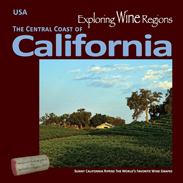
 |
Exploring Wine Regions: The Central Coast of California
by Michael C. Higgins, PhD
The International Exploration Society
Photojournalist Higgins has channeled his love of California, travel, and excellent cuisine and wines into this spectacular volume. As much a journey for the senses as it is a guidebook, this third volume in the Exploring Wine Regions series is a masterpiece that will please not only novice and expert travelers and wine connoisseurs but will also impress anyone who loves to thumb through an excellent resource book of any type. This is a volume that will be visited, revisited, and cherished for both the information presented as well as the enjoyable reading experience. Higgins has made it easy to spend countless hours planning or daydreaming about a wine-tasting tour along California’s stunning central coast. Whether one chooses a day or weekend tour or devotes an entire vacation to the region, there are many choices to be made about what to see, what to do, and where to dine and drink fine wines.
This reference title brings the facts as well as historical relevance to the forefront in nicely measured, pertinent overviews. If one is new to the language of grape growing and winemaking, the volume will also increase one’s vocabulary and knowledge of the diversity of the high-quality wines produced in central California, “a little sliver of land that runs from south of San Francisco all the way down the coast to include all of Baja California... wine regions geologically distinct from the rest of California with thick layers of ocean sediment, hard granitic rock, quartz diorite, and serpentine rock.” The image- and fact-packed narrative is also supported by a glossary of wine terminology, a comprehensive index, and tantalizing descriptions of the other five volumes in the Exploring Wine Regions series. Each section for each county also lists a plethora of outstanding natural features and popular outdoor activities and cultural attractions. Within the narrative are over thirty informative maps and tables. There is very little that Higgins has not included in the book, and his ability to capture and condense the essence of these regions is impressive.
With over 400 full-color pages and 800 images, the book leaves virtually no stone unturned in its overviews of the Central Coast regions of California: Monterey County, San Luis Obispo County, and Santa Barbara County. These counties are “home to thirty of California’s 147 Appellations (AVAs: American Viticultural Areas). Higgins reports that more than 600 of California’s 4,700 total wineries are located on the central coast—roughly 90,000 acres of vineyards growing over sixty types of grapes—and the book also features an astounding array of tasting rooms and restaurants that he has personally visited and vetted. Conveniently listed are the physical particulars of each listing—names, addresses, websites, contact info, and even a symbolic pricing scale for approximate costs of these experiences. These places, whether wineries, restaurants, natural features, or regional events, are truly elevated as multidimensional experience options that educate and entertain under Higgins’ insightful examination. The book is organized for traveling from the north in Monterey County southward to Baja California.
One of the beauties of understanding this region is that it is still a work in progress, so to speak. This is because though vineyards have been planted there since the gold rush days of the nineteenth century, it was not until the 1970s that planting started as a full-fledged commercial endeavor. Central California growers and vintners are still exploring and expanding their skills in the twenty-first century, still discovering the many permutations and interactions of place, climate, and crops that are bringing international attention and awards to the diverse wines of this diverse region. Thankfully, Higgins has provided an excellent guide for those who wish to experience the wine culture of the region either vicariously or firsthand.
RECOMMENDED by the US Review